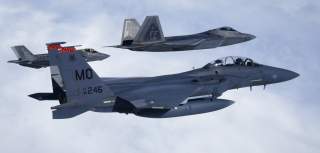How F-35 Joint Strike Fighter and F-22 Raptor Pilots Train for War
And yes, I have the video to prove it.
The U.S. Air Force’s Atlantic Trident 17 exercise brought together some of the NATO alliance’s most capable combat aircraft including the fifth-generation Lockheed Martin F-22 Raptor and the F-35A Joint Strike Fighter as well as the British Eurofighter Typhoon and the French Dassault Rafale at Joint Base Langley Eustis in Virginia.
But to train for war, someone has to play the part of the bad guy—or Red Air in Air Force parlance. In the case of Atlantic Trident, the task of flying as red air fell to the 366th Fighter Wing’s 391st Fighter Squadron, which flies the powerful Boeing F-15E Strike Eagle, and the 1st Fighter Wing’s 71st Fighter Training Squadron, which flies the T-38A Talon.
The exercise’s host, Col. Peter Fesler, commander of the 1st Fighter Wing—which flies the Raptor—told me that the F-15Es and T-38s would replicate some of the highest end air-to-air threats during the trilateral exercise. “Without getting into the specifics of which type aircraft we’re going up against, the most modern threat fighters we can face up there is what we’re simulating,” Fesler told me.
The primary aggressor aircraft for the exercise was the F-15Es, which flew into Langley from Mountain Home Air Force Base in Idaho. With the Air Force only having two remaining squadrons dedicated to performing the adversary mission, the service is increasingly pressing frontline fighter units and contractors into the aggressor role. This time around, it was the 391st Fighter Squadron’s turn.
“There is a really good combination of adversaries on this exercise,” Wing Commander Chris Hoyle, commanding officer of the RAF’s 1(Fighter) Squadron told me. “The Strike Eagle is a very good replication of a [Russian-made Sukhoi] Flanker.”
According to Hoyle, the Strike Eagle has a very similar radar cross-section to the Flanker series—which is one of the primary threats the NATO alliance expects to faceoff against in the air. Moreover, the Strike Eagle offers similar aircraft performance as the Flanker, Hoyle said. “So that’s one of our baseline threats,” Hoyle said. “Most Western air forces will baseline their threat against the Flanker and the Strike Eagle is perfect at replicating that.”
Teaming the F-15E with the T-38A—which has a much smaller radar cross section—makes for a formidable combination of aggressors. The smaller jet—though it does not have the avionics, sensors or performance of a fourth-generation fighter—is a challenging aggressor, Hoyle said.
“The T-38—which has a much smaller radar cross-section—you have to look a little bit harder to target those groups and they’re very, very proficient at being red air targets for the community here at Langley,” Hoyle said. “They’re very used to doing red air. They're wily, they’re experienced and they’re also very knowledgeable. So the combination of those two platforms gives us great training.”
The T-38As—as the pilots I flew with during my red air sortie explained (and yes, the video above was me in a T-38A)—were replicating the Russian-made Mikoyan MiG-29 Fulcrum. While the T-38A has nowhere near the performance, the avionics or sensor capability of the MiG-29, the Air Force takes advantage of Soviet/Russian air combat doctrine to overcome some of the platform limitations of the Talon to provide a very realistic threat presentation with the diminutive advanced jet trainer at beyond visual range distances. The T-38As do not fight within visual range with the Raptors—they will “knock it off” at the merge if it gets to that point.
Part of the equation of turning the ancient T-38A into credible adversary is the sheer experience and prodigious skills of the Talon crews—many of whom like my friend “Fangs” have been flying the Raptor since the earliest days of the F-22s’ initial operational test period. Another part of the equation is the Talon crews’ intimate familiarity with the Raptor and its capabilities.
But the U.S. Air Force is also fully aware of the equipment; the capabilities and the tactics used by America’s would be adversaries. As such, even if the T-38A is far from the perfect red air “bandit,” the U.S. Air Force’s superb fighter pilots overcome the Talon’s limitations using a combination of innovative thinking, skill and experience. The 71st FTS has it covered.
Dave Majumdar is the defense editor for The National Interest. You can follow him on Twitter: @davemajumdar.

